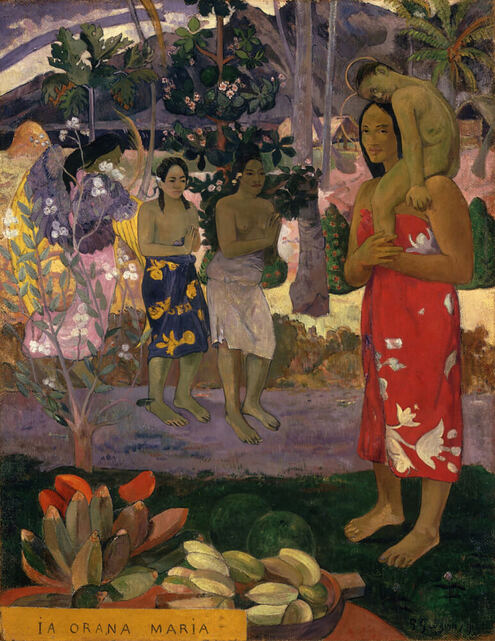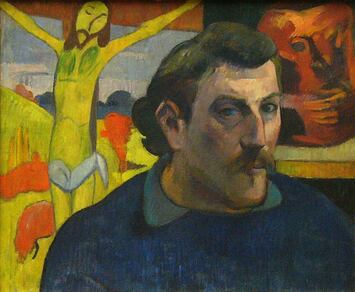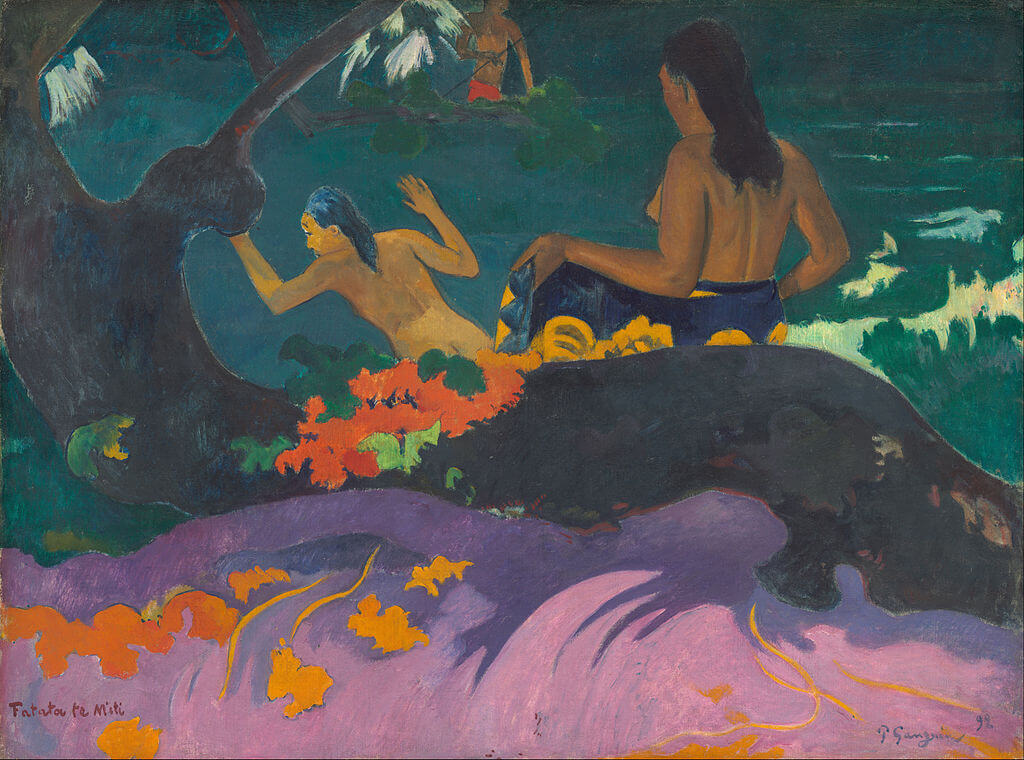|
Where? Gallery 825 of the Metropolitan Museum of Art
When? 1891 What do you see? This painting contains five people. On the right is Mary with her naked child Jesus sitting in an odd pose on her shoulder. Both have a halo around their head and are looking at the viewer. Mary is wearing a red pareo (which is a dress that is wrapped around the middle or higher and is typical for people in Tahiti and the Cook Islands) wrapped around her with a hibiscus flower motif on it. On the left, you can see a female angel (probably representing the Archangel Gabriel) dressed in pink and with blue and yellow wings. The angel is partly hidden behind a flowering tree. The angel points out the presence of Mary and Jesus to the two Tahitian women on the purple path. These two women are dressed in a pareo from the waist down, and they fold their hands in devotion. In the foreground is a collection of fruit laying on a fata, which is a wooden altar that Polynesians use to make offers to their gods. These fruits may be an analogy to the gifts that the three Magi brought to Jesus after his birth. The fruit includes red and yellow Tahitian bananas (some of which are in a wooden bowl) and the green breadfruit in the center. In the background, you can see the dark mountains, a lake, palm trees, and flowering bushes. There is a boathouse on the right side of the lake.
What is Hail Mary? Also known as the Angelic Salutation or Ave Maria, Hail Mary is a prayer in the Catholic Church. The full text of this prayer is:
“Hail Mary, full of grace, the Lord is with thee. Blessed art thou amongst women and blessed is the fruit of thy womb, Jesus. Holy Mary, Mother of God, pray for us sinners, now, and in the hour of our death. Amen.” This prayer is the most popular prayer aimed at Mary and asks for her help in intervening between the person praying and God. Who is Gauguin? Eugène Henri Paul Gauguin (1848-1903) is a Post-Impressionist artist who is known for his experimental use of colors. Vincent van Gogh and Edgar Degas were important for Gauguin in developing his unique style. In 1891, Gauguin moved to Tahiti to start a new life. His idea was to set up a community of painters, called l’atelier des tropiques in an area that was far away from home and did not suffer from the materialism that was present in France. The main idea behind this initiative was to stimulate the role of spirituality in their artworks and to expose themselves to different cultures and religions. In the end, no other painters joined him, and he left alone to Tahiti. However, this did not have a negative effect on the quality of Gauguin’s work, and he produced some of his best works during this period, including By the Sea (Fatata te Miti) in the National Gallery of Art and Spirit of the Dead Watching (Manao Tupapau) in the Albright–Knox Art Gallery in Buffalo. Most of Gauguin’s paintings are based on his imagination, and he expressed in a letter to his wife that he believed that his artistic center was in his mind and did not need to be inspired by other painters.
Fun fact: Gauguin did not have any models from Tahiti in front of him to paint this picture, but rather painted this based on his imagination and some other stimuli that he brought to Tahiti. For example, as Tahitians were not walking around half-naked, the two women in the middle are modeled after the figures of dancers on a bas-relief of the Javanese Borobudur temple of which he had brought a picture. Also, the pose of Jesus on top of Mary’s shoulder was based on a postcard that Gauguin bought during his trip to Tahiti. Moreover, Gauguin was one of the first artists to depict Mary and Jesus with a colored skin, something that was not allowed yet by the Catholic Church.
Written by Eelco Kappe
References:
0 Comments
Leave a Reply. |
Categories
All
|
- Home
- Blog
-
Museums
- Alte Pinakothek
- Art Institute of Chicago
- Baltimore Museum of Art
- Barber Institute of Fine Arts
- Bargello
- Barnes Foundation
- British Museum
- Church of Sant’Anastasia
- Cleveland Museum of Art
- Courtauld Institute of Art
- Detroit Institute of Arts
- Frans Hals Museum
- Galleria Borghese
- Gallerie dell'Accademia
- Getty Museum
- Guggenheim
- Hermitage Museum
- Kunsthistorisches Museum
- Kunstmuseum Basel
- Legion of Honor Museum
- Louvre
- Mauritshuis
- Metropolitan Museum of Art
- Musee d’Orsay
- Museum of Fine Arts in Boston
- Museum of Modern Art
- National Gallery in London
- National Gallery of Art
- National Museum in Poznań
- Norton Simon Museum
- Ny Carlsberg Glyptotek
- Palace of Versailles
- Palazzo Pitti
- Palazzo Vecchio
- Petit Palais
- Philadelphia Museum of Art
- Prado
- Pushkin Museum
- Ravenna Art Museum
- Rijksmuseum
- San Diego Museum of Art
- Santa Maria delle Grazie
- St. Peter's Basilica
- Städel Museum
- Statens Museum for Kunst
- Tate Britain
- Tate Modern
- Timken Museum of Art
- Uffizi
- Vatican Museums
- Wallace Collection
-
Artists
- Altdorfer
- Anguissola
- Berlin Painter
- Bosch
- Botticelli
- Boucher
- Bronzino
- Bruegel the Elder
- Brunelleschi
- Cabanel
- Caillebotte
- Canova
- Caravaggio
- Carpeaux
- Cezanne
- Cimabue
- David
- Degas
- Delacroix
- De Maria
- Donatello
- El Greco
- Fontana
- Fra Angelico
- Fragonard
- Gauguin
- Gentileschi
- Gericault
- Gonzalez-Torres
- Goya
- Hals
- Hogarth
- Hokusai
- Ingres
- Leonardo da Vinci
- Lippi, Filippo
- Longhi, Barbara
- Lorrain
- Makovsky
- Manet
- Massys
- Matisse
- Merian
- Michelangelo
- Mochi
- Modigliani
- Monet
- Panini
- Parmigianino
- Perugino
- Picasso
- Pisanello
- Raphael
- Rembrandt
- Renoir
- Reynolds
- Rivera
- Rodin
- Rubens
- Scultori
- Seurat
- Steen
- Tintoretto
- Titian
- Toulouse-Lautrec
- Turner
- Uccello
- Van der Weyden
- Van Dyck
- Van Eyck
- Van Gogh
- Van Hemessen
- Vasari
- Velazquez
- Vermeer
- Veronese
- Vigée Le Brun
-
Locations
- Books
- About Us




